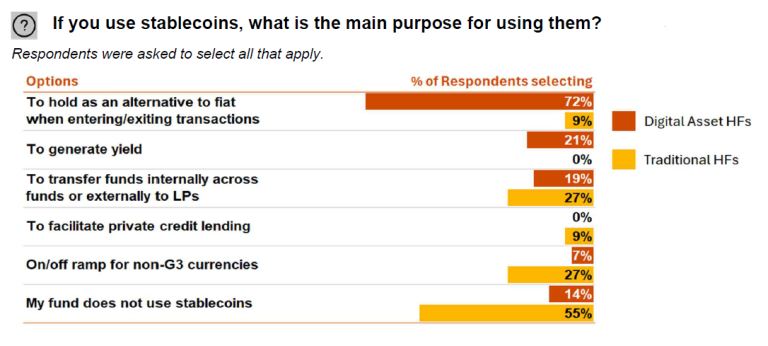The Alternative Investment Management Association (AIMA) published its sixth annual global crypto report, which explores the evolving digital assets investment landscape for hedge funds.
Key findings:
- Digital asset investments rise as regulatory clarity and ETFs boost confidence: Nearly half (47%) of traditional hedge funds surveyed this year have exposure to digital assets, up from 29% in 2023 and 37% in 2022, driven by increased regulatory clarity and the launch of spot cryptocurrency ETFs in Asia and the US.
- Among those already invested, 67% plan to maintain the same level of capital employed while the remaining 33% plan to invest more capital by the end of 2024.
- More sophisticated investment strategies, shifting to derivatives: There has been a notable shift towards derivative trading in digital assets by traditional hedge funds, with its use rising to 58% in 2024 (up from 38% in 2023), while spot trading dropped to 25% this year after peaking at 69% last year. This signals growing sophistication in hedge fund strategies.
- Growing interest in tokenization despite regulatory challenges: Interest in fund tokenization is also growing, with 33% of hedge fund respondents either committed to or exploring tokenization, compared to around a quarter of traditional hedge funds last year. Among digital asset focused hedge funds, 12% are already investing in tokenized assets, although regulatory challenges remain the biggest hurdle to wider adoption.
- Rising institutional client demand: 43% of traditional hedge funds—whether invested or not in digital assets—are seeing increased interest from institutional clients. Currently, family offices and high-net-worth individuals (HNWIs) remain the largest investor categories in digital asset focused hedge funds, followed by fund of funds.
- Hedge fund sector remains cautious: Despite the industry’s growth, many traditional hedge fund managers remain hesitant, with 76% of those not currently invested in digital assets unlikely to enter the space within the next three years, up from 54% in 2023. The top barrier, cited by 38% of funds, is the exclusion of digital assets from investment mandates, rising from fourth place last year. While regulatory uncertainty remains a key concern, it has eased somewhat due to the adoption of clearer regulatory frameworks like the EU’s MiCA.

James Delaney, managing director for Asset Management Regulation at AIMA, said in a statement: “The findings from this year’s report indicate a steady recovery in confidence over the past year. Institutional investors are showing renewed interest, driven by several key factors including increased regulatory clarity, such as the European Union’s MiCA [Markets in Crypto-Assets] regulation, advancements in infrastructure, and the approval of new products like spot bitcoin and ether ETFs by the US Securities and Exchange Commission.
“There’s also growing attention on the longer-term use of blockchain technology – or tokenization – to support efficiencies within asset management. At AIMA, we continue to support the institutionalization of this rapidly evolving asset class through advocacy, operational guidance, and educational initiatives.”

